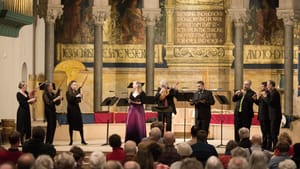Stay in the Loop
BSR publishes on a weekly schedule, with an email newsletter every Wednesday and Thursday morning. There’s no paywall, and subscribing is always free.
Old music, fresh performance
Piffaro presents Christmas in Southern Germany

Many of our Christmas traditions, including the season’s music, have roots in Germany. For its beautiful holiday program, Piffaro (Philadelphia’s Renaissance band) explored this musical heritage by diving deeply into specific Christmas tunes, most of them from sacred music. Some were familiar to a general audience, some were known mostly by specialist musicians, but all were presented with the ensemble’s trademark accessible musicality grounded in scholarship that translates so clearly to their fervent audiences. (After three live concerts in early December, a recording will be available to stream from Friday, December 22, 2023, to Thursday, January 4, 2024.)
Artistic director Priscilla Herreid opened by remarking how the instruments that they play were integral to the music of this geographic area. Piffaro musicians each play multiple instruments (something expected of Renaissance wind band musicians in that era), and their remarkable “instrumentarium” of more than 50 pieces includes recorders, shawms, dulcians, sackbuts, krumhorns, bagpipes, lutes, guitars, and a variety of percussion, all careful reconstructions from the period.
German and Italian influences
The concert began in Advent (the Christian liturgical season leading up to Christmas) with one of the most familiar German chorale tunes of that season, Nun komm der Heiden Heiland (Savior of the nations, come). This Latin hymn (formerly sung only by priests or the religious) was set in German by Martin Luther so that worshippers could partake in congregational singing. The chorale’s eight verses tell the complete story of the birth of Christ, allowing all worshippers to sing and understand the Biblical tale.
In several of the concert’s eight sections, a chorale tune was first introduced and then followed by settings from different composers. Here, the Nun komm section was opened by Clara Rottsolk singing a cappella, her warm and pristine soprano matching perfectly with this music. She gave the first and several other verses, with intermittent instrumental configurations by varying forces—sometimes for as few as two instruments, sometimes for the full ensemble of seven. Of the composers in this section, the most familiar was Hans Leo Hassler (c.1564-1612), one of the first German composers to study in Italy and bring that new Italianate style back home.
Mixing music and languages
The concert’s fifth section was one of the most memorable, a medley of three German Christmas melodies set by Michael Praetorius (1571-1621), the most well-known of the composers on this program, in a beautiful arrangement by Piffaro founder Joan Kimball. The first two chorale tunes, Dies est laetitiae (This is the joyful day) and Psallite unigenite (Now we sing), were played instrumentally. For the third (and most familiar) of the program’s tunes, In dulci jubilo (In sweet rejoicing, sing and be glad), Rottsolk joined the instrumentalists. This chorale’s lyrics feature macaronic text (a mixture of languages), here back and forth between Latin and German.
For the sixth grouping of the concert, the ensemble focused on a specific location: St. Anna’s Church in Augsburg, where composer Adam Gumpelzhaimer (1559-1625) oversaw the music. In her excellent program notes, Herreid writes that he was also “a sort of curator” of the music library there, and it’s due to his meticulous records that a vast number of Renaissance works have survived. His canon on Cantate Domino (Sing to the Lord) was arranged for the Piffaro forces by Grant Herreid, who was also the lutenist. He and Rottsolk also had a beautiful lute/voice duet in the concert’s seventh section, one dedicated to the familiar song Joseph, lieber Joseph mein (Dearest Joseph), also a macaronic work.
An authentic transport
The concert closed with a section built around a redux of the familiar and tuneful In dulci jubilo. Rottsolk vocally opened the set, after which the ensemble played three different treatments, adding an instrument each time to culminate in a six-part setting by Leonhard Paminger (1495-1567), another important Lutheran musician. Piffaro then took the chorale’s words to heart, ending the concert by encouraging people to join with them in Hassler’s arrangement, printed in the program. The audience complied, singing joyfully, to end an afternoon of uplifting music.
In the 19th century, my family emigrated to America from this exact area of Germany, where they had deep roots. So it was especially uplifting to imagine these chorales and instrumental works being experienced and sung by them exactly as we were hearing them today. The magic of Piffaro is their ability to transport audiences to the past by playing this “old” music with the same freshness, clarity, and force that it must have had for those who first heard it more than 500 years ago.
What, When, Where
Christmas in Southern Germany. Piffaro (Priscilla Herreid, Grant Herreid, Greg Ingles, Erik Schmalz) with guest artists Clara Rottsolk (soprano) and instrumentalists Héloïse Degrugillier, Sian Ricketts, and Stephanie Corwin. December 8-10, 2023, at various locations; streaming online ($21) December 22, 2023-January 4, 2024. (215) 235-8469 or piffaro.org.
Sign up for our newsletter
All of the week's new articles, all in one place. Sign up for the free weekly BSR newsletters, and don't miss a conversation.

 Gail Obenreder
Gail Obenreder